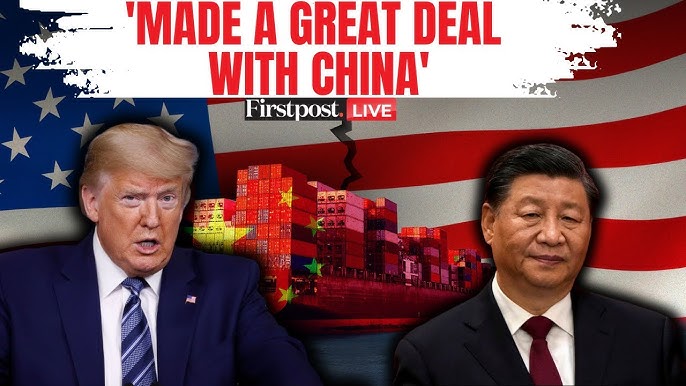Court rulings could weaken the U.S. administration’s tough stance in trade talks and give trading partners more room to maneuver. But policy uncertainty means that high-stakes trade negotiations could go either way.

“We just signed with China the other day,” U.S. President Trump said during an event at the White House late on Thursday, June 26, without providing further details.
Recently, the U.S. Court of International Trade ruled that President Donald Trump had overstepped his authority by imposing sweeping tariffs under the International Emergency Economic Powers Act. The decision dealt a significant blow to the administration’s tariff policies. Now, Trump’s trade team is exploring other legal avenues to enforce the tariffs. The future trajectory of these policies will depend on a final ruling by the U.S. Supreme Court and the administration’s subsequent actions.
New uncertainties loom for global trade. On March 31, the Office of the U.S. Trade Representative released the 2025 National Trade Estimate Report on Foreign Trade Barriers. Then, on April 2, Trump invoked the IEEPA, calling the U.S. trade deficit a “national emergency” to excuse the imposition of a 10 percent ad valorem baseline tariff on imports, and even higher “reciprocal tariffs” on countries that have large trade surpluses with the U.S. These include China (34 percent) and the EU (20 percent).
On May 28, the trade court ruled that Trump’s executive order to impose tariffs was illegal and blocked its enforcement. This was a major judicial setback for the administration’s tariff policies. The court ruled that Trump had exceeded his authority by imposing tariffs under IEEPA, which does not grant the president unlimited power to regulate imports. A trade deficit does not meet the “unusual and extraordinary threat” standard under IEEPA and does not qualify as an “emergency.” Any connection to any applicable “emergency” is far-fetched.
The court further noted that allowing the president to impose tariffs via IEEPA would encroach on Congress’s exclusive constitutional power to regulate trade, violating the separation of powers that is fundamental to the American political system. The court emphasized that presidential powers under the International Emergency Economic Powers Act are clearly limited and cannot override congressional authority.
The court also noted that the U.S. Constitution explicitly grants to Congress the power to impose tariffs and to regulate trade, finding that Congress did not, and could not under the Constitution, grant the president “unbounded authority to impose unlimited tariffs on goods from nearly every country in the world.”
Trump’s tariff policies are now confronted with formidable legal challenges. Initially, there was a high degree of legal uncertainty, and the Trump administration filed an appeal with a three-judge panel of the Court of Appeals for the Federal Circuit. On June 10, the judges blocked the trade court’s injunction against Trump’s tariffs — a ruling that allows the continued collection of tariffs until arguments are made before the full panel of 12 appeals court judges. This “en banc” hearing is scheduled for July 31.
Given the different interpretations of the IEEPA by various lower courts, this could further intensify judicial conflicts and prompt litigants to urge the U.S. Supreme Court to settle the matter quickly. However, the ultimate outcome hangs in the balance.
Second, the legal basis for the tariffs is tenuous. The Trump administration may soon face more lawsuits because invoking the IEEPA to impose tariffs is both rare and of questionable legality.
Because the tariffs are a central element of Trump’s “Make America great again” (MAGA) mantra, the administration will not likely concede to the judiciary on the tariff ruling. Various reports indicate that the White House is exploring alternative options to secure new legal justifications and judicial interpretations for imposing tariffs.
One potential approach has two steps. First, the administration could invoke Section 122 of the Trade Act of 1974, which empowers the President to swiftly impose a maximum 15 percent tariff on all imports for up to 150 days in cases of a severe balance-of-payments deficit or significant dollar devaluation. First, the goal would be to address trade imbalances by imposing a 15 percent tariff globally for a period of 150 days. Second, within this 150-day window, the administration could cite Section 301 of the Trade Act of 1974 to develop custom-tailored tariffs for each major trading partner. Section 301 has been invoked multiple times in the past, including to hit China with tariffs during Trump’s first term.
However, as things stand now, even if Trump were to resort to alternative avenues, his tariff policy would still be hemmed in by domestic politics. For one thing, Congress might well give the policy tighter scrutiny and could enact new legislation to rein in presidential trade powers. Moreover, there is no shortage of discord within the Republican Party, with some Republican lawmakers wary of any further tariffs.
Taking all these factors into account as the July 9 tariff suspension deadline approaches, the Trump administration may well pivot its negotiation tactics to pursue compromised deals with its major trading partners as a hedge against potential reversals in courts at home. The judicial rulings could potentially pull the rug out from under the Trump administration in trade negotiations, giving trading partners more room to maneuver.
But the policy uncertainty means that the high-stakes trade negotiations between the U.S. and its major trading partners could go either way. The possibility of a renewed escalation in global trade tensions cannot be ruled out.
